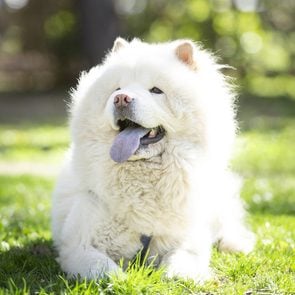13 Dogs with Blue Eyes That Are Stunning
Updated: Apr. 05, 2024

These beautiful dogs with blue eyes are almost always the result of a happy genetic accident that became a desired trait
When you see dogs with blue eyes, you probably do a double-take. The trait is striking, but it’s also relatively rare, with no more than about 5% of the adult canine population sporting beautiful blue eyes.
But when you see a purebred dog with blue eyes, chances are those gorgeous peepers are no accident of genetics—at least not anymore. We spoke with two canine geneticists from the National Institutes of Health (NIH) to shed some light on the topic: Elaine Ostrander, PhD, is a canine geneticist who leads the Cancer Genetics and Comparative Genomics Branch of the National Human Genome Research Institute at the NIH. Her colleague, Dayna Dreger, PhD, is a staff scientist whose research includes the genetics of dog coat color, breed development and population structure, breed history and breed behavior. We also heard from Link Welborn, DVM, the chief veterinary officer at Covetrus.
“Blue eyes in dogs are like a lot of aesthetic traits,” says Dreger. “They’re striking, and they really stand out. The hypothesis is that it’s a genetic mutation that developed naturally and then became a desired trait.” Ostrander explains that each purebred, registered dog is part of a closed population. When a new trait pops up, she says, you can use careful breeding to flood the population with that trait pretty quickly. If blue eyes are seen as desirable, they can become an accepted standard for that breed of dog. “The physical characteristics of modern breeds are aesthetic choices,” adds Dreger. “So the attitude is, ‘Unless blue eyes can be connected to some health problem, then why not?'”
However, genetic variants aren’t always predictable, despite the efforts of breeders. While some breeds are more likely to have blue eyes, says Dreger, “I don’t know of a breed where every dog will have blue eyes.” For example, she says any breed with a merle color pattern—a genetic pattern in a dog’s coat and on its skin that creates spotted patches of pigmentation—could have blue eyes, but that doesn’t mean that it will have blue eyes.
Note also that blue eyes are not well-received by most AKC breed standards. They are allowed in any of the merle-colored breeds and some of the spotted breeds, but with rare exceptions, they are considered faults, often to the point of disqualifying a dog from the show ring. That doesn’t mean they’re not enchanting—just that they aren’t going to win Best in Show at Westminster!
With those uncertainties in mind, let’s get to know 13 dog breeds that are most often known to have this rare physical trait.
Get Reader’s Digest’s Read Up newsletter for more pets, humor, travel, tech and fun facts all week long.
About the experts
|
1. Siberian husky
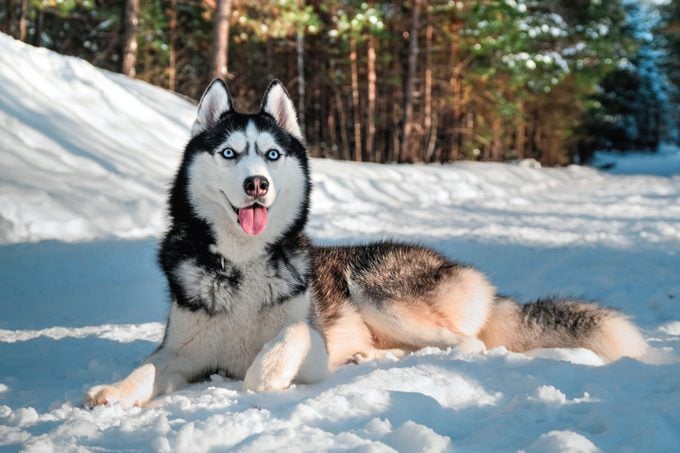
Known for its thick coat, high energy and endurance, the Siberian husky is one of the best-known breeds associated with blue eyes. Like the wolves they resemble, huskies are pack animals, meaning they embrace hanging out with other pups. They also need lots of space to run and burn off their energy, so a large yard is a must. Their blue eyes are especially striking against their white, gray and black coats. These often-stubborn dogs are not prone to deafness (see FAQs, below), “but they just decide not to listen,” says Dreger. “It’s a choice.”
2. English setter
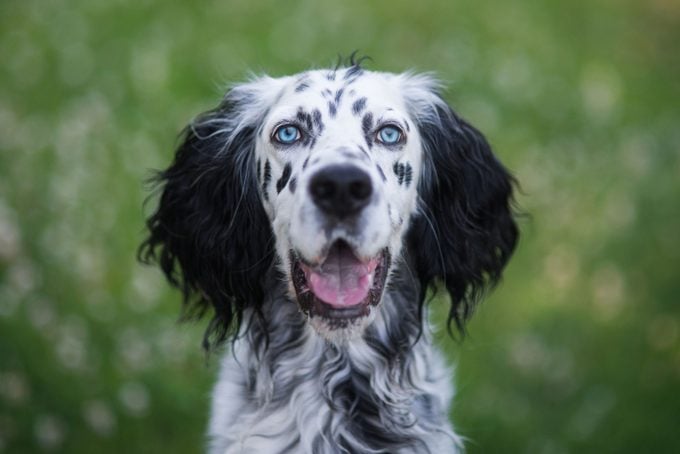
The English setter is a merry medium-sized pup (it tops out at 80 pounds for males and 55 pounds for females) with a unique speckled coat. Though their eyes are typically brown, they can sometimes have blue eyes, notes Dr. Welborn. A 2019 study by the British Veterinary Association concluded that English setters have a 4.5% chance of being born deaf or hearing deficient. As is the case with deafness-prone breeds like Dalmatians, English cocker spaniels and bull terriers, hearing impairment is likely related to pigmentation, including eye color, says Dr. Welborn. This is one of the breeds that doesn’t allow blue eyes according to the breed standard, which calls for “brown eyes, the darker the better.
3. Weimaraner

The Weimaraner is a medium-sized pooch with a sleek, silvery-gray coat that often has a small white spot on the chest. Its eyes are pale in color too—usually amber or a steel-like blue-gray. The American Kennel Club (AKC) recommends having this sporting dog’s eyes evaluated, along with its hips and thyroid function, calling any Weimaraner eye color other than gray, blue-gray or light amber a “very serious defect” that would likely result in the dog being removed from the official breeding population.
4. Dalmatian
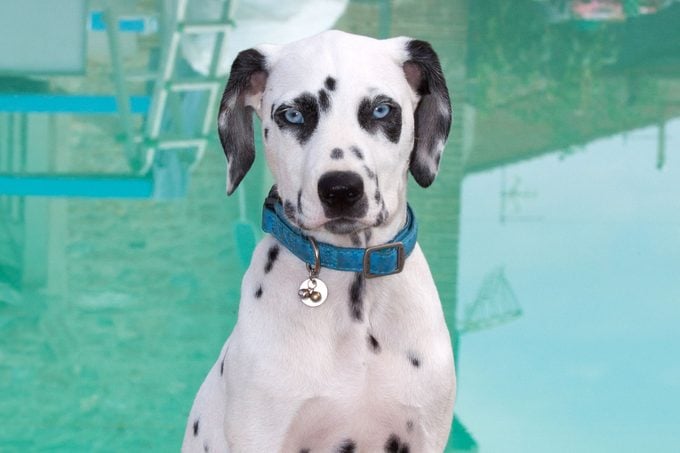
Known for its white coat with black spots and hanging out with firemen, the Dalmatian is a medium to large dog with a muscular build and athletic disposition. Because of their energy, these graceful trotting dogs are perfect companions for avid outdoors enthusiasts, and their loyalty makes them superb watchdogs too. Dalmatians have either brown or blue eyes, though blue is rarer. Unfortunately, Dalmatians have a higher rate of deafness than any other breed, and it appears that blue-eyed Dalmatians are even more likely to be completely or partially deaf, though Ostrander says that the correlation between blue eyes and deafness still needs further study.
5. Border collie

This lovable and smart herding pup has a small to medium build and a longer, weather-resistant double coat. While brown eyes are most common in this breed, there are some border collies with blue eyes. They may also have what’s called heterochromia (Latin for “different colors”).
“Congenital heterochromia irides with one solid blue eye is a normal eye color variation, and these dogs have normal vision,” says Dr. Welborn. “However, congenital heterochromia iridis [yes, only one letter difference between the two terms] refers to the same iris having different areas of pigmentation—for example, brown and blue areas in the same eye.”
Ostrander, who has worked with border collies, shares an anecdote: Some border collie owners swear that a blue-eyed dog is even more intimidating to the sheep it’s herding!
6. Dachshund

German for “badger hound,” the dachshund is a small and spunky German breed that has some serious hunting skills (hence its name). Today, they’re endearingly referred to as “wiener dogs” because of their resemblance to a hot dog: a long torso with four short legs. Dachshunds can have either long or short hair, and they typically have chocolate-brown eyes. In very rare cases, they can have blue eyes or sometimes just one blue eye and the other brown, especially if they possess the merle (dappled) gene.
7. Cardigan Welsh corgi
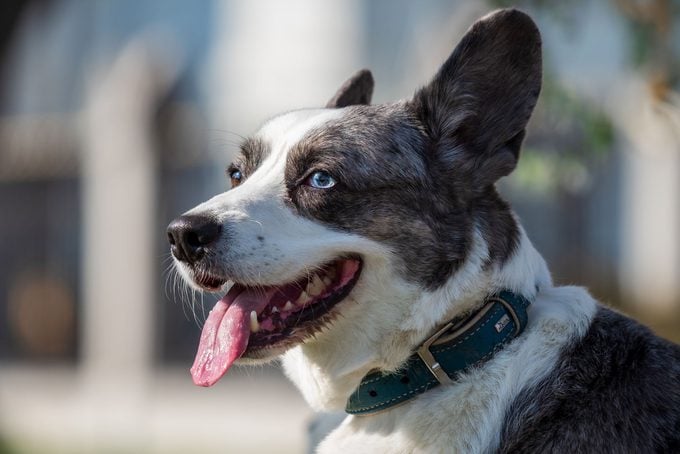
The Cardigan Welsh corgi has a similar build to the dachshund, with a long torso and short legs, though this herding breed is slightly larger at 25 to 38 pounds. These dogs come in several coat colors, including red and blue merle, and they have long and fluffy tails. But don’t confuse a Cardi with a Pembroke Welsh corgi. Famously the favorite dog breed of Queen Elizabeth II, Pembrokes don’t have long tails.
According to the AKC’s official standard of the Cardigan Welsh corgi, blue eyes (including partially blue eyes) or one dark and one blue eye are permissible in blue merles, but they’re a disqualification in corgis with any other coat color.
8. Australian shepherd
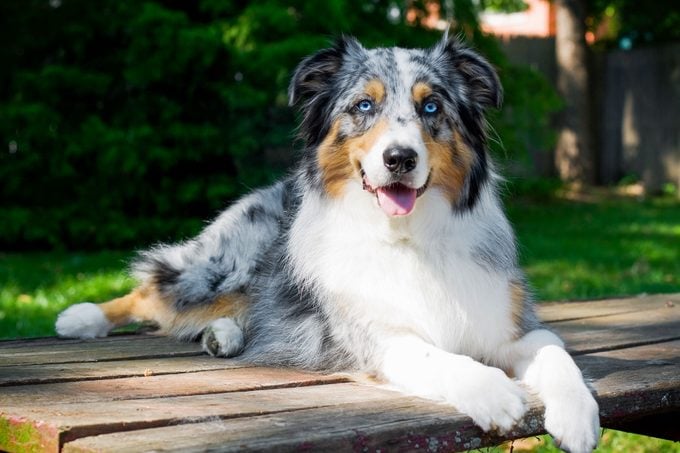
An adorable member of the herding group, this pup is an especially popular merle dog breed (though not all have merle coloring) with green eyes, blue eyes, brown eyes or heterochromia, two different colored eyes. Their coat is medium length and somewhat coarse, and they have a bobbed tail and an agile, muscular build. All of this makes for a truly striking appearance, and it’s what makes them such natural herders across many climates. Because merle is a dominant trait that causes problems when two copies are present in a dog, breeders need to be especially careful not to breed two merles together and create puppies with so-called double merle, which have a much higher risk of being born blind and deaf.
9. Great Dane
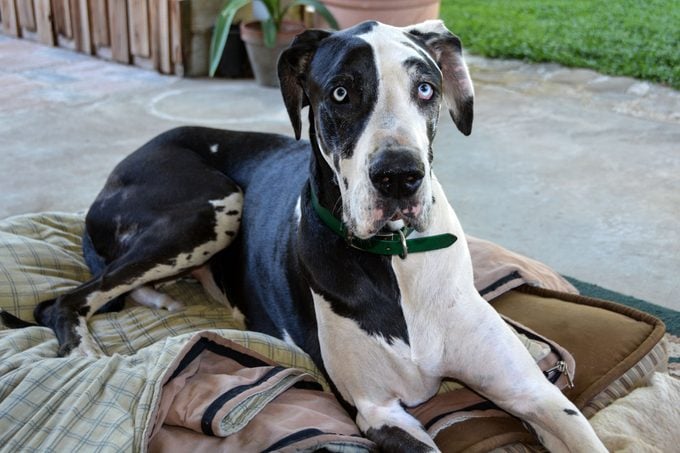
The majestic and noble-looking Great Dane has a lean, svelte build and iconic oversize ears that you’ll spot pointy or adorably flopped over. Despite their size—one of the largest breeds, they weigh between 140 and 175 pounds—Great Danes are gentle giants. Things get a little interesting when it comes to their eyes. There are many Great Dane puppies with blue eyes, but their eye color typically shifts to amber or brown as they grow older. In rare cases, their eyes may remain blue. Per the AKC Great Dane standard, blue eyes are only allowed in merle or harlequin-colored Danes.
10. Labrador retriever

Labrador retrievers consistently top out as one of the most popular dog breeds, and for good reason. They have an inherently sweet and loyal disposition, are easy to train and are known for being one of the smartest dog breeds. This breed comes in three primary colors: yellow, chocolate and black. As is the case with many pups on this list, they more commonly have brown or amber eyes. Sometimes—often when mixed with other breeds—there may be chocolate or black dogs with blue eyes in this family of pups, though the AKC considers anything but brown or amber as outside the breed standard.
11. Bull terrier
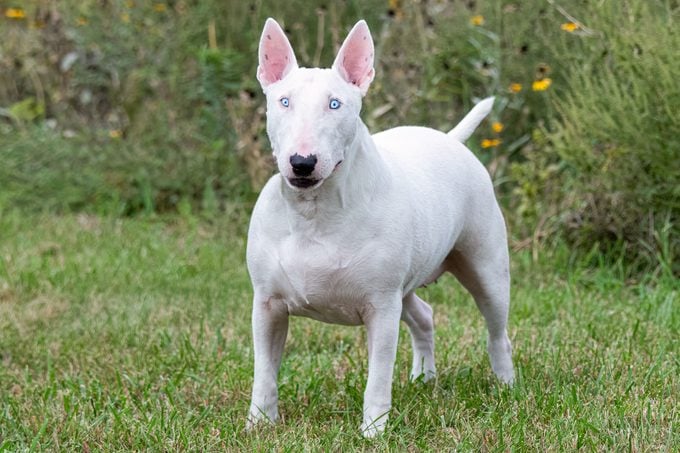
You’ll know a bull terrier when you see one! It’s a distinguished and unusual-looking pup with a broad and rounded snout, pointy ears and a muscular, medium-sized white body. Its triangular eyes are often dark brown, but in very rare cases, you may see this white dog with blue eyes. This is more common in the case of a bull terrier being crossbred with a merle dog—and it also disqualifies the pup from shows and AKC-registered breeding.
12. Catahoula leopard dog
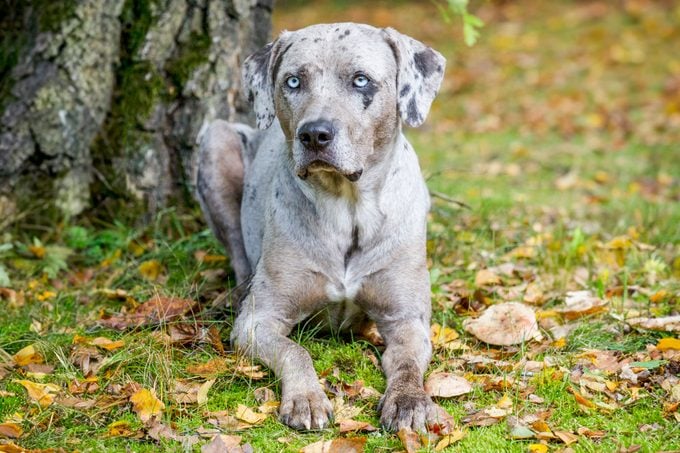
These dogs got their name from their multicolored, spotted coats and short, sleek fur. Merles are common with this breed and, interestingly, Catahoula double-merles have a lower incidence of deafness and blindness compared to double-merles of other breeds. Catahoula are known for their distinctive eye color, which can be light shades of amber, green, blue or brown; their eyes are often two colors in combination. This working breed was developed in Louisiana, where it was traditionally a companion to hunters and herders—it still needs a job to do and a lot of room and time to burn off its energy.
13. Shetland sheepdog
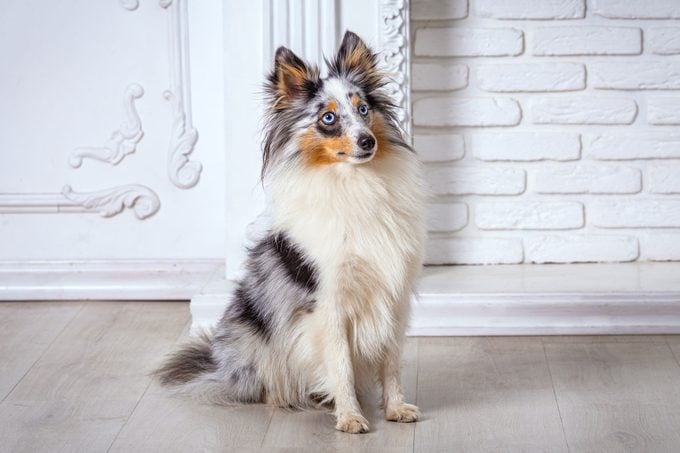
A relative of the border collie, Shelties are herding dogs that, similar to their cousins, do best when they have a job to do, whether it’s agility training, frisbee catching or endless games of fetch. Some Shelties have the merle gene, which, aside from causing patches of black, sable, white and tan in their coats, may cause them to have blue eyes. However, the AKC breed standard allows blue eyes only in blue merle Shelties—for all others, their careers as runway models are kaput.
FAQ
How rare is it for a dog to have blue eyes?
Some studies suggest that fewer than 5% of all dogs have blue eyes into their adulthood. (Like human babies, many puppies are born with blue eyes that change color over time.)
Where are you most likely to find dogs with blue eyes? Ostrander says that blue-eyed dog populations vary greatly depending on location. For example, there are a lot more huskies in the cold climates of the Pacific Northwest than there are in South Florida.
Why do some dogs have blue eyes?
Blue eyes are an incidental effect of other coat color patterns that are desired traits. So in essence, they are just along for the ride in merles and piebald dogs. (The exception may be in the Siberian husky, whose eyes are not associated with either of these patterns.) When the unwanted mutation pops up in a breed where it’s not desired, it’s essentially eliminated from the breeding chain (by not allowing that dog to reproduce). Ostrander offers up an example: “You’ll never see a Doberman with blue eyes because it doesn’t fit the breed persona.”
Can dogs with blue eyes see OK?
“To our knowledge,” says Ostrander, “dogs with blue eyes see just as well as other dogs. The blue is just the color of the iris, so it doesn’t affect the cornea or other parts of the eye.” However, the blue iris actually lets more light through it, and under bright conditions, it may make it harder to adjust to the glare, or it could even damage the retina, so you may wish to shield your blue-eyed dog from bright sunlight.
Are blue-eyed dogs more likely to be deaf?
Dreger explains that because Dalmatians, especially those with blue eyes, have a greater tendency to be deaf or partially deaf, the idea was extrapolated to other breeds. But while Dalmatians do have a significantly higher risk of deafness than other breeds, researchers have yet to identify a definitive cause and can’t confirm that blue eyes equal deafness.
In other breeds, the presence of the merle gene, which can cause blue eyes, is also a risk factor for deafness and vision problems. This happens when two dogs with the merle gene reproduce and create double merle puppies, which are more likely (but not always) to be born deaf, blind or both. But again, that means that the double merle can cause deafness and blue eyes in dogs, not that blue eyes equate to deafness.
Another factor is the piebald mutation, which causes a lack of pigmentation, including of the eyes, and is also linked to deafness. (Note that piebald and albino syndrome are not the same; albino animals will suffer from impaired vision or blindness, but there’s no known correlation between albinism and hearing impairment.) Albino dogs do in fact have blue eyes, and they may be a case of people breeding because they like their looks (albino Dobermans are probably the best-known example). However, no breed club condones breeding albino dogs.
Why trust us
At Reader’s Digest, we’re committed to producing high-quality content by writers with expertise and experience in their field in consultation with relevant, qualified experts. For this piece, Elizabeth Heath tapped her experience covering dog behavior and health, and then Caroline Coile, PhD, an award-winning journalist specializing in canine breeds, health and science, gave it a rigorous review to ensure that all information is accurate and offers the best possible advice to readers. We relied on reputable primary sources, including two canine geneticists and a veterinarian, as well as our writer’s personal experience. We verified all facts and data and backed them with credible sourcing, and we will revisit them over time to ensure they remain accurate and up to date. Read more about our team, our contributors and our editorial policies.
Sources:
- Elaine Ostrander, PhD, canine geneticist who leads the Cancer Genetics and Comparative Genomics Branch of the National Human Genome Research Institute at the National Institutes of Health; phone interview, Feb. 16, 2024
- Dayna Dreger, PhD, staff scientist with the National Human Genome Research Institute at the National Institutes of Health; phone interview, Feb. 16, 2024
- Link Welborn, DVM, chief veterinary officer at Covetrus and past president of the American Animal Hospital Association; email interview 2022
- Vet Record: “Congenital sensorineural deafness in English setters in the United Kingdom: prevalence and association with phenotype and sex”
- Louisiana State University: “Genetics of Deafness in Dogs”























